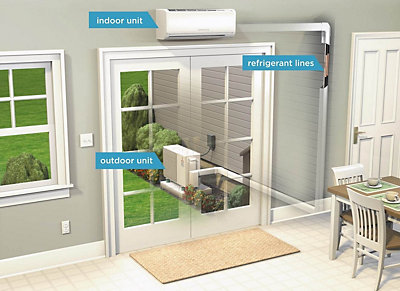How Much Does It Cost to Install a Ductless AC in Denver?
The installation cost of a ductless AC in Colorado can vary significantly.
Here's why there's such a big difference in cost:
- How many units you need
- The size of the ductless unit(s)
- The type of ductless unit(s) you choose
- Installation considerations
- The ductless AC installer you choose
In this article, we’ll go into more detail about each of these factors to help you understand the cost of your ductless AC installation.
Cost factor #1: How many units you need
The number of ductless units you need depends on how many rooms you want cooled. The more rooms you need cooled in your home, the more ductless equipment you’ll need, which raises the overall cost of the installation.
Ductless mini-split air conditioners have 3 main parts:
- The condenser (outdoor unit)
- The evaporator (indoor unit)
- Conduit (refrigerant and electrical lines)

A basic ductless mini-split system
If you only need one room cooled, your ductless system setup will look like the image above. That’s called a single-zone system (one outdoor unit with one indoor unit).
However, if you need multiple rooms cooled, your ductless system will need 1 indoor unit per room. Luckily, 1 outdoor unit can handle up to 4 indoor units. If your setup involves multiple indoor units, it’s called a multi-zone system.
Since multi-zone systems require more indoor units (and a second outdoor unit, if you have more than 4 indoor units), the cost is greater than a single-zone unit.
Cost factor #2: The size of the ductless unit(s)
Air conditioner size is measured in BTUs (British Thermal Units). The higher the BTU output of your ductless unit, the bigger and more expensive it is.
When it comes to ductless size, you want to make sure you get the correct size for room(s) you want to cool.
- If you get a ductless unit that’s too small for the room you want to cool, the unit will struggle to cool your room and you’ll often feel uncomfortable.
- If you get a ductless unit that’s too big, it will cool your room really quickly and then shut off, which leads to higher energy bills and damage to parts because of the frequent start/stop.
So how do you find the right size ductless unit?
You need to have a professional perform a cooling load calculation on the room(s) you want to cool.
A cooling calculation takes into account factors like:
- The square footage of the room
- The number of windows and doors the room has
- Height of the ceilings
- Proximity to kitchen (or if the room is the kitchen)
- The type of flooring
- How well-insulated the room is
- And much more
Related article: How to Estimate AC Size for Your Home
Cost factor #3: The type of ductless unit(s) you choose
While size isn’t a factor you have a lot of choice in, ductless units have other features you can choose based on your preferences.
Let’s look at 2 things you can choose when buying a ductless unit(s):
Ductless AC energy efficiency (SEER)
Energy-efficient ductless models save you more on your monthly energy bills, but they’re also more expensive upfront.
Ductless system energy efficiency is measured by SEER (Seasonal Energy Efficiency Ratio). Most ductless units range from 13 to 21 SEER. The higher the SEER, the more energy efficient the system.
For help determining SEER size, read our article: SEER vs SEER: Comparing AC Efficiency Ratings for Your Home.
Add-on features
You can add the following comfort features to your ductless AC, but they will raise the cost of the unit:
- Wireless remote control
- Adjustable airflow
- Washable air filters
- Multiple speed fans
- Programmable thermostats
- Special dehumidification features
Cost factor #4: Installation considerations
Besides the cost of the actual ductless system itself, you’ll also have to factor in the cost to install the system.
Some installation considerations that increase prices include:
- Running refrigerant/electrical lines through hard-to-access places like basements or attics
- Outdoor units that are far from the indoor units (requires longer refrigerant and electrical lines)
- Adjusting your home’s electrical capacity (you may need to hire an electrician to adjust your home’s voltage to accommodate a ductless system)
Cost factor #5: The ductless AC installer you choose
Generally, higher-quality contractors with more experience charge more for their installation services.
However, you get what you pay for. A high-quality contractor will do better work, which means your ductless AC system will perform better and need fewer repairs in the long run.
How do you know if a contractor is experienced and does good work?
If a contractor is high quality, they’ll...
Need help from a Colorado Plumbing, Heating, Cooling, or Electrical Specialist?
For your convenience, you can request an appointment in one of two ways:
- Call us at (303) 436-2525 for immediate assistance.
- Click on the button below to schedule your appointment online.
Related Reading
Join Our Email Newsletter
Receive updates, current news, promotions, and industry tips.
